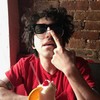(l-r.) Academy Award nominee Amy Adams stars as Susan Morrow and Neil Jackson as Christopher in writer/director Tom Ford’s romantic thriller NOCTURNAL ANIMALS, a Focus Features release. Credit: Merrick Morton/Focus Features
Academy Award nominee Amy Adams stars as Susan Morrow in writer/director Tom Ford’s romantic thriller NOCTURNAL ANIMALS, a Focus Features release. Credit: Merrick Morton/Focus Features
(l-r.) Andrea Riseborough stars as Alessia and Michael Sheen as Carlos in writer/director Tom Ford’s romantic thriller NOCTURNAL ANIMALS, a Focus Features release. Credit: Merrick Morton/Focus Features
Armie Hammer stars as Hutton Morrow in writer/director Tom Ford’s romantic thriller NOCTURNAL ANIMALS, a Focus Features release. Credit: Merrick Morton/Focus Features
Academy Award nominee Amy Adams stars as Susan Morrow in writer/director Tom Ford’s romantic thriller NOCTURNAL ANIMALS, a Focus Features release. Credit: Merrick Morton/Focus Features
Academy Award nominee Amy Adams stars as Susan Morrow in writer/director Tom Ford’s romantic thriller NOCTURNAL ANIMALS, a Focus Features release. Credit: Merrick Morton/Focus Features
An interior shot of The Morrow's modern LA home from writer/director Tom Ford's romantic thriller NOCTURNAL ANIMALS, a Focus Features release. Credit: Merrick Morton/Focus Features
An interior shot of The Morrow's modern LA home from writer/director Tom Ford's romantic thriller NOCTURNAL ANIMALS, a Focus Features release. Credit: Merrick Morton/Focus Features
An interior shot of The Morrow's modern LA home from writer/director Tom Ford's romantic thriller NOCTURNAL ANIMALS, a Focus Features release. Credit: Merrick Morton/Focus Features
The carport at The Holt residence features a large sculpture from their fine art collection in writer/director Tom Ford’s romantic thriller NOCTURNAL ANIMALS, a Focus Features release. Credit: Merrick Morton/Focus Features
Entry - Richard Misrach, "Desert Fire #153 (Man with Rifle)," 1984 (Photograph)
Dining Area - Sterling Ruby, Title Unknown
Living Room - Robert Motherwell, Untitled (Elegy), 1950-1956 (Painting) / Aaron Curry, Untitled, 2011 (Sculpture) / Andy Warhol, Shadow, 1980 (Painting)
Bedroom - Mark Bradford, Untitled, 2015 (Painting) / Alexander Calder, 23 Snowflakes, 1956 (Sculpture)
Morrow Office - John Currin, Nude in Convex Mirror, 2015 (Painting)Holt Residence:Driveway - Tony Smith, Title Unknown, Date Unknown (Sculpture)
Entry - Joan Mitchell, Looking for a Needle, 1958 (Painting) / Julian Schnabel, Untitled, 2008 (Painting)
Living Room - Robert Polidori, Death of Marat, 1985 (Photograph) / Robert Polidori, Salle de Bain Marle Antoinette, 2006 (Photograph)
Dining Room - Jack Pierson, Torse de’Atlete Marble, 2010 (Photograph)Los Angeles Museum:Lobby - Damien Hirst, Saint Sebastian, Exquisite Pain, 2007 (Sculpture)
Walkway - "Revenge" Painting, Designed and created by Nocturnal Animals Art Department and Tom Ford
An interior shot of The Morrow's modern LA home from writer/director Tom Ford's romantic thriller NOCTURNAL ANIMALS, a Focus Features release. Credit: Merrick Morton/Focus Features
